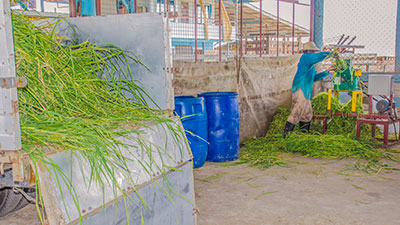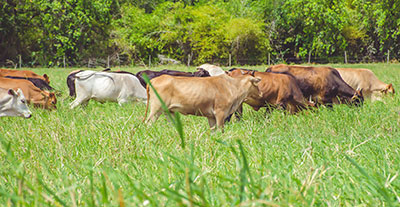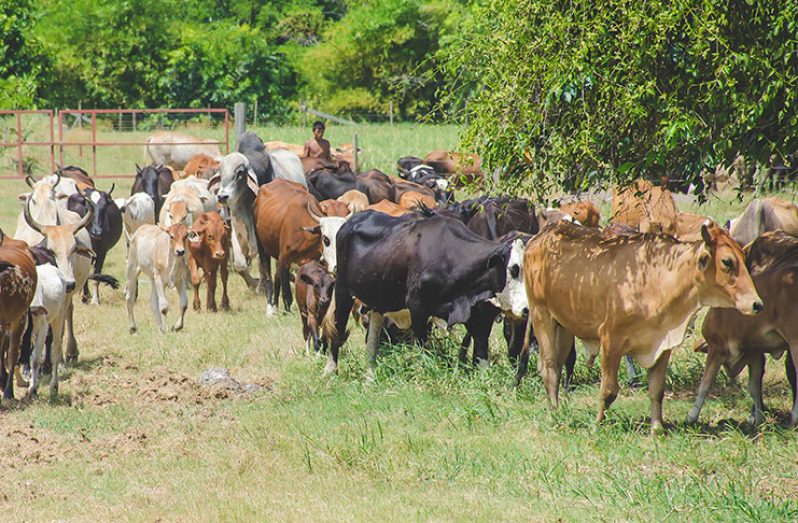– How farmers are being helped to modernise their operations
Guyana’s beef industry has its roots in the 1800s and when demand started to grow, the great Rupununi cattle trail was created.

In what reads as a great epic tale, vaqueros would drive hundreds of heads of cattle from ranches in the Rupununi all the way to Tacama in the Berbice River (the home of the Army’s jungle training base). From there, the animals were loaded onto barges and sailed to the Rosignol train station for transport to the capital Georgetown and other locations, all covering over 400 miles.
You’d think that by now, the country would have figured a way to satisfy all its demand for beef and be exporting to the bountiful market available just in the Caribbean, but that’s not the case.

The Marriott Hotel in Georgetown gets its choice cuts of steak from the U.S. and Rossignol Butchery in the capital has to even import cow heel to satisfy the demand of customers.
Foreigners working in Guyana, including those attached to mining companies also import some of their meat.
SO WHAT’S THE PROBLEM?
The quality of a beef animal depends on at least four factors: age, breed, health and the quality and quantity of pastures and supplements. And that’s the struggle Guyana’s industry

continues to face.
But the Guyana Livestock Development Authority (GLDA) is trying to change the way the industry operates and is enlisting cattle farmers who are willing to modernise their operations and meet local demands even before thinking of export market.
On a visit to Guyana back in 2007, Dr. Steven P Washburn, Professor and Extension Specialist, Department of Animal Science, North Carolina State University, said that for Guyana to achieve successful beef production, farm improvements including water control, fencing, pastures, and handling facilities were required.
He said too there should be records to know how one’s animals were performing, including simple things like knowing the weight of the cattle and the carcass weight (beef) once the cow is slaughtered.
SUNDARBAN
One of the farmers who has taken on the challenge to modernise his operation is Mr Harripersaud Ramsewack, who operates Sundarban farm at Hopeland, East Coast Demerara.
The farm, which now has just over 400 cows and calves, has been in operation for the past 17 years and bit by bit, he is taking the advice of the Livestock Authority to improve his operation.
A major part of his operation is ensuring that his animals are fed right. To achieve that, he is investing in pasture grounds. Currently, he has 300 acres of Antelope grass under cultivation, while another 200 acres has natural grass species.
These two types of pastures utilise a rotational grazing system and allows sufficient time for re-growth so that the animals have optimum use of the grass species, explains Fenton Nickram, the National Coordinator for the Beef Sector.
To meet the constant demand for growing animals, in particular calves, Mr Ramsewack has resorted to harvesting the Antelope grass and chipping it using his grass chopper machine, so that there will be little wastage.
Once chipped, molasses is added to improve the energy level and improve palatability.
“It smells like chocolate,” he said, looking into silage bins that have been set up at Sundarban farms.
Explaining the process, Nickram said the grass is cut into one inch pieces and then compressed into layers of about four inches thick after which the molasses is poured on each layer in order to exclude oxygen.
“When the requisite height of the bins are reached, the surfaces are sealed using canvas and covered with various sealing agents to ensure the anaerobic process takes place for curing,” Nickram explained.
After 6 to 8 weeks the silage is ready for use. As needs be this cured silage is given to animals whenever the farmer wants.
Apart from this, Mr Ramsewack utilises his Hay Bailor, and compacts rice straw into bails ranging from 25 pounds to one tonne.
This is stored and used, with molasses, to feed the animals during the very dry spells when there is not enough grass.
Mr Ramsewack knows too that cutting the grass at the right time is also important, because, if, for example, the Antelope grass is allowed to “flower” then it loses its protein content. All of this he would not have known were it not for the help of the Livestock Authority.
Further, for his breeding programme, Mr Ramsewack utilises the breeding bulls suggesting by the Livestock Authority and this together with embryo transplant and artificial insemination leads to improvement in the genetics of his herd and lends to greater profitability.
“Sundarban farm achieves higher birth weights in calves, better weight gains, faster growth rate, and animals are weaned earlier,” Mr Nickram attested.
“This farmer’s investment will reap greater dividends within the next two to three years when he would have reached close to 1000 head of cattle and at this stage will be in a state of readiness to improve market opportunities,” Mr Nickram added.
The farmer knows that he has much more work to do, but he is willing to follow the lead of the Livestock Authority to improve his operation.
“I want to reach a stage where we can move to export market, but I know I have to reach a certain standard and follow instructions.”
LIVESTOCK AUTHORITY
The beef industry is perhaps one of the oldest in the local livestock sector , and today the best estimate is that the number of heads is 200, 000-250, 000 heads.
The coast has always been known for beef and dairy cattle, whereas the Rupununi was mainly beef cattle.
The Rupununi is known for its beef cattle and enjoyed a thriving industry until the 1970s when foot and mouth disease halted exports to the coastland.
The coast, because of easy access to market, maintained a robust industry and in the heydays of the industry, the Livestock Development Company had a number of large ranches, with some having as much as 15, 000 heads.
The Livestock Authority suggests that the best days for beef cattle had to be between 1970 and 1990s.
During that period, there was the Ebini ranch, which was owned by the Livestock Development Company, which functioned as the premier breeding centre. Farmers were able to buy improved breeds of cattle.
With the demise of the Livestock Development Company, farmers no longer had ready access to breeding animals.
In 2010, the Ministry of Agriculture, with the support of the Inter-American Development Bank started the Agriculture Diversification Programme, and among its objectives was the development of the livestock sector, including beef cattle.
This led to the formation of the Livestock Authority, which Mr Cumberbatch now heads.
He said that the programme brought in 33 live bulls and 25 were given to beef farmers along the coast. Later, females of the same breeds of males, namely the Brahman/Zebu, the Beef Master and the Brangus, were brought in.
Some of the bulls were kept by the Livestock Authority to be used for semen collection at the Ebini lab, where live breeding is also done.
In addition, embryos and semen of the three breeds mentioned were also brought in.
LACK OF ABATTOIRS
This was all done with the aim of improving the genetics of the beef cattle on the coast, Mr Cumberbatch stated. The overall intention was to allow Guyana to export beef, but other factors, such as the lack of certified slaughter facilities that meet international standards has not allowed that to happen.
Mr Cumberbatch said that Guyana lost the opportunity during the 2010-2013 period to construct modern abbatoirs.
“We’re again having discussions and hopefully if this other IDB programme we are trying to get comes through, there is a real possibility that we will get an abattoir,” he stated.
However, he said that “there are a number of things that come along the way” that can cause Guyana not to have modern abattoirs, but he is hopeful.
“There is a real possibility that we will get it here on the coast as well as in the Rupununi – two pilot abattoirs – and it would certainly assist in ensuring that we can fulfill the dream of exporting,” Mr Cumberbatch stated.
But even before reaching the export market, Mr Cumberbatch said that farmers should aim to meet local demands of the hospitality sector.
“The beef that is imported is at the top end of the market, choice pieces. That is what our farmers should be looking at initially.”
He said that to achieve this, farmers would need to step up to the plate and engagement in modern technologies, ending the “open gate and chase” method of rearing cattle.
Currently, a farmer has to wait until about four years to get beef to the market, but with the right type of animal, proper feeding and better management of the animal overall, Mr Cumberbatch said that time could be reduced to two years.
The Livestock Authority sees it as easy good breeding animals, good management systems, and good grass and water.
With efforts like that of Mr Ramsewack and his Sundarban farm, Mr Cumberbatch is confident farmers can take care of total demands for beef in Guyana before moving on to the export market in the future.




.png)









